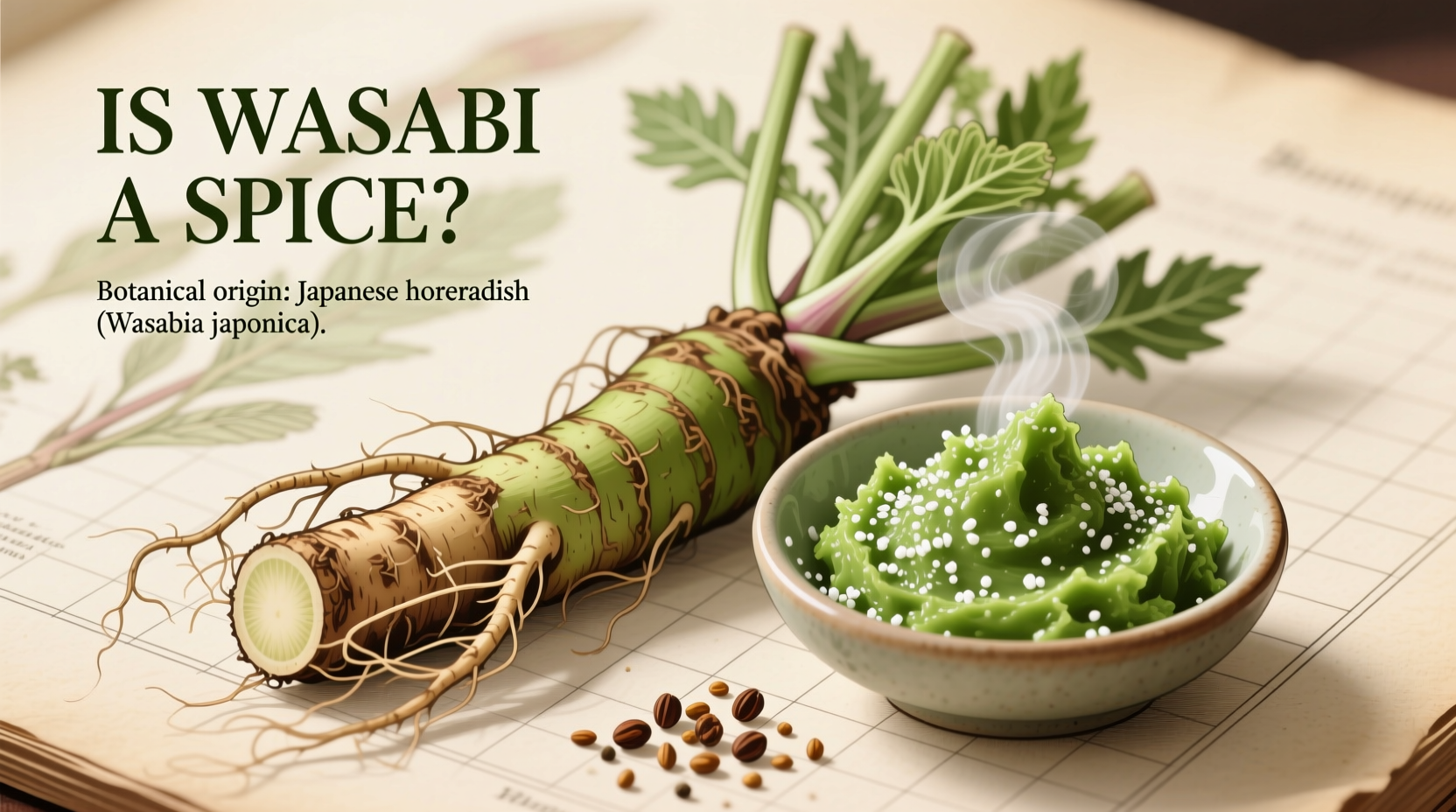What Wasabi Really Is: Beyond the Green Paste Myth
When you ask is wasabi a spice, the answer reveals a fascinating culinary misconception. True wasabi (Eutrema japonicum) is a living plant native to Japan's mountain stream beds, not the powder or tube paste most Western diners encounter. Its heat comes from volatile compounds called isothiocyanates, which dissipate within 15 minutes of grating—unlike capsaicin in chili spices that lingers for hours.
The Wasabi You Know vs. Real Wasabi: A Critical Distinction
Over 95% of "wasabi" served globally contains zero actual wasabi. Restaurants typically use a blend of horseradish, mustard powder, and green food coloring. This substitution exists because genuine wasabi:
- Requires specific cool, shaded stream environments to grow
- Takes 18-24 months to mature (vs. 6 months for horseradish)
- Costs 10-15 times more than horseradish-based alternatives
| Characteristic | Real Wasabi | Common Substitute |
|---|---|---|
| Primary Ingredient | Eutrema japonicum rhizome | Horseradish + mustard powder |
| Heat Duration | 15-20 minutes | 30+ minutes |
| Nutritional Profile | Rich in calcium, potassium, vitamin C | Primarily horseradish nutrients |
| Market Price (per kg) | $160-$200 | $15-$25 |
Why Wasabi Isn't Classified as a Spice
The culinary world distinguishes between spices (dried seeds, fruits, roots, or vegetables used for flavoring) and condiments (fresh preparations served alongside food). Wasabi falls into the latter category because:
- It's used fresh, never dried or powdered (authentic preparation)
- Serves as an accompaniment rather than an ingredient
- Loses potency rapidly after preparation
According to the USDA Agricultural Research Service, wasabi's classification as a condiment aligns with Japanese culinary tradition where it's grated tableside to preserve volatile compounds. This contrasts with spices like black pepper that maintain flavor when dried and stored.

Historical Context: Wasabi's Journey Through Time
Understanding is real wasabi a spice requires examining its historical role:
- 10th Century: First documented use in Japan as medicinal herb
- 1603-1868 (Edo Period): Became standard accompaniment for sushi to prevent foodborne illness
- 19th Century: Western chefs misclassified it as a "Japanese spice"
- 1960s: Horseradish substitute developed for global sushi expansion
- 2020s: Authentic wasabi cultivation expanding in New Zealand and Oregon
Practical Implications for Home Cooks
Knowing is wasabi considered a spice matters when cooking authentic Japanese cuisine. Real wasabi:
- Should be grated with sharkskin grater (or fine ceramic) for optimal texture
- Requires 3-minute rest after grating to develop full flavor
- Loses heat rapidly—never mix with soy sauce in advance
- Complements delicate fish better than harsh horseradish substitutes
For those seeking authentic experiences, the Japanese Culinary Academy confirms that proper wasabi application enhances umami without overwhelming fish flavors—a balance impossible with artificial substitutes.
How to Identify Real Wasabi Products
When shopping for genuine wasabi, look for:
- Whole rhizomes: Should feel heavy with earthy aroma (sold refrigerated)
- Paste tubes: List "Wasabia japonica" as first ingredient (not horseradish)
- Powder: Extremely rare and expensive (requires fresh water activation)
- Color: Natural pale green (artificial versions are neon green)
Be aware that USDA labeling regulations allow products with as little as 2% real wasabi to be marketed as "wasabi." True wasabi products typically cost $30+ for a 2-ounce tube.
Why the Classification Matters
The distinction between is wasabi a spice or condiment affects more than terminology—it impacts culinary technique. Chefs at Tokyo's Tsukiji Market explain that real wasabi's transient heat requires precise timing:
"Authentic sushi dining involves placing wasabi between fish and rice so heat develops as you eat. Mixing it with soy sauce destroys the delicate flavor progression that defines traditional omakase." — Sushi Master Kenji Yamamoto
This context explains why Japanese culinary institutions like the Tokyo Culinary Institute teach wasabi handling as part of advanced condiment mastery rather than spice blending techniques.











 浙公网安备
33010002000092号
浙公网安备
33010002000092号 浙B2-20120091-4
浙B2-20120091-4